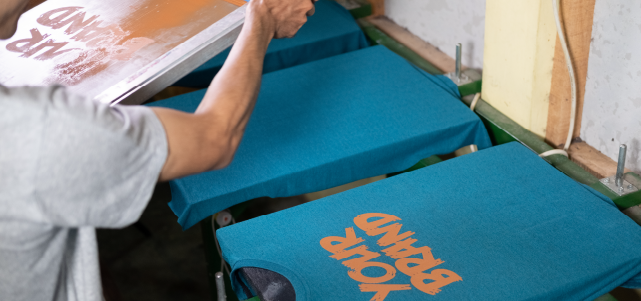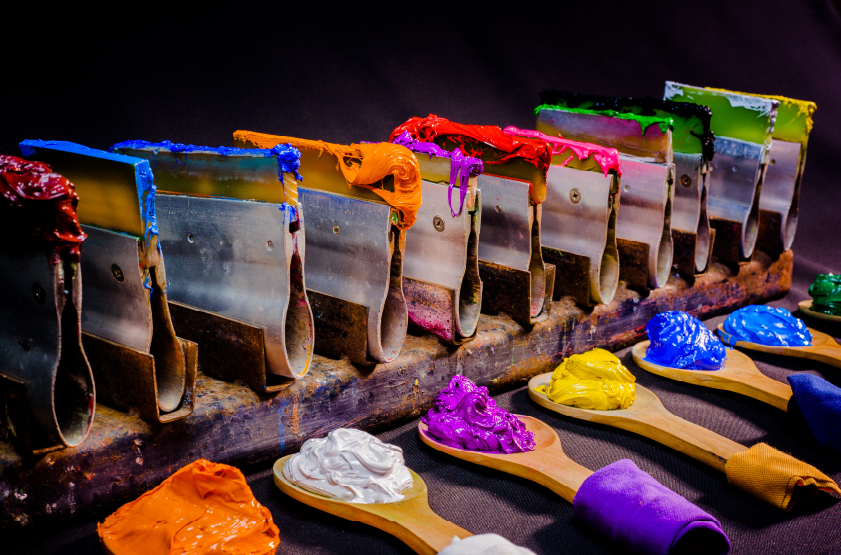Screen printing is a popular method for printing designs onto various surfaces, such as fabric, paper, and plastic. While the process may seem straightforward, there are several simple tips and tricks that can help improve the quality of the final product. In this blog, we will discuss some of the key strategies for enhancing screen printing at various stages.
Improvements at Each Stage
Design
Choose Appropriate Colors: Choosing the right colors for the design is also important for screen printing production. It’s best to choose colors that are easy to mix and work with, as well as colors that are compatible with the final product. For example, red and white create great contrast, among other combos. Additionally, it’s important to consider the color of the substrate being printed on, as this can affect how the colors appear on the final product.
Test the Design: Before committing to a final design, it’s a good idea to test it on a small scale. This can involve creating a sample print or test run to check for any issues or errors. By testing the design, screen printers can identify and correct any issues before they become larger problems during the production process.
Work with a Professional Designer: If design isn’t your forte, it’s best to work with a professional designer who has experience creating designs for screen printing. A professional designer can help create a design that is optimized for the screen-printing process, ensuring that the final product looks great and is easy to produce.
Pre-Press
Properly Prepare the Artwork: Before printing, it’s important to properly prepare the artwork for the printing process. This involves cleaning up the design, separating it into color channels, and adjusting the colors and contrast as needed. By properly preparing the artwork, screen printers can ensure that the final product is accurate and consistent.
Use High-Quality Screens: High-quality screens are essential for achieving consistent and high-quality prints. This involves properly tensioned screens that are free from defects or damage and has a uniform mesh count. By using high-quality screens, screen printers can ensure that the ink is applied evenly and accurately, resulting in a high-quality print. Generating screens using the latest technology such as computer-to-screen or CTS equipment makes a positive difference in quality.
Properly Expose the Screens: Properly exposing the screens is another key factor in achieving high-quality prints. This involves using the appropriate exposure time and distance, as well as ensuring that the emulsion is properly cured. By properly exposing the screens, screen printers can ensure that the design is accurately reproduced on the final product.
Printing
Use Proper Ink Viscosity: Proper ink viscosity is essential for achieving consistent and high-quality prints. The ink should be thick enough to adhere to the substrate but not so thick that it causes issues during printing. Additionally, it’s important to mix the ink thoroughly before printing to ensure that the color is consistent throughout.
Control Ink Deposit: Controlling the ink deposit is another key factor in achieving high-quality prints. This involves using the appropriate squeegee pressure, angle, and speed to apply the ink evenly and accurately. It’s also important to use the proper screen tension and off-contact distance to achieve the right ink deposit.
Monitor the Printing Process: Monitoring the printing process is essential for catching any errors as they occur. This involves checking the prints regularly for consistency and accuracy, as well as making adjustments as needed. Additionally, it’s important to keep the printing environment clean and organized to prevent contamination or other issues.
Drying and Curing
Use Proper Drying Techniques: Proper drying techniques are essential for achieving consistent and high-quality prints. This involves using the appropriate drying temperature, airflow, and time to ensure that the ink dries evenly and thoroughly. It’s also important to ensure that the substrate is completely dry before moving on to the curing phase.
Use Proper Curing Techniques: Proper curing techniques are essential for ensuring that the ink is durable and long-lasting. This involves using the appropriate curing temperature, time, and energy to ensure that the ink is properly cured. It’s important to ensure that the curing equipment is properly calibrated and maintained to achieve consistent results.
Test the Prints: Testing the prints is essential for ensuring that the ink is properly dried and cured. This involves checking the prints for any issues or errors, as well as conducting various tests to ensure that the ink is durable and long-lasting. It’s important to conduct these tests regularly to ensure that the ink is consistently meeting quality standards.
Quality Control
Conduct Regular Inspections: Conducting regular inspections is essential for catching any issues or errors as they occur. This involves inspecting the prints for consistency, accuracy, and overall quality. It’s important to identify any issues early in the production process to save time and resources on flawed prints.
Use Standardized Testing Methods: Using standardized testing methods is essential for ensuring that the final product meets quality standards. This involves conducting various tests, such as wash tests, abrasion tests, and color tests, to ensure that the ink is durable and long-lasting. It’s important to document these test results and use them to inform any necessary adjustments to the printing process.
Continuously Improve Processes: Continuously improving processes is essential for achieving greater efficiency and consistency in screen printing production. This involves analyzing data from the quality control phase, as well as feedback from customers and employees, to identify areas for improvement. By continually refining processes, screen printers can achieve greater efficiency, consistency, and quality in their printing operations.
Innovative Screen-Printing Solutions
Screen printing can be a highly effective way to transfer designs onto various surfaces. By following the tips outlined above, designers and printers can improve the quality of their final product at every stage of the process. By creating high-resolution designs, properly aligning screens, maintaining consistent pressure and ink density during printing, drying, curing the ink correctly, and conducting thorough quality control checks, screen printing can be a highly successful and efficient method of creating high-quality prints.
EXILE Technologies offers a range of products and solutions designed to help screen printers improve their screen-printing operations. Their products include high-quality emulsion coatings, exposure units, drying systems, and more, all designed to help screen printers create high-quality prints with greater efficiency and accuracy. By utilizing EXILE Technologies’ products and solutions, screen printers can streamline their workflow, reduce waste, and increase their output, resulting in higher profits and greater customer satisfaction. With its commitment to innovation and customer service, EXILE Technologies is a valuable partner for any screen-printing business looking to improve its operations.





